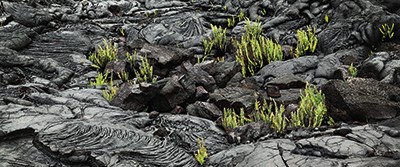A Volcano’s Good Deeds

By Lynne Lescott
It’s hard to imagine something good coming out of Hawaii’s recent Kilauea volcano eruptions after seeing dramatic video of its lava streams swallowing roads, homes, and beaches. Yet despite their destructive force, volcanoes actually help to restore the ecosystem.
Destructive Power
The eruption of any volcano involves lava flows and the release of gases and volcanic ash. In Hawaii, lava streams from Kilauea’s eruption have ruined acres of agricultural land, wildlife habitat, and neighborhoods. The volcano also released toxic gases that can injure the lungs of people and wildlife.
Eruptions like Kilauea’s also eject volcanic ash miles high into the atmosphere, where it can form clouds that drift for thousands of miles with air currents. Air carries ash, but the ash carries harmful gases and jagged mineral particles. One gas in particular — sulfur dioxide — can combine with water to create sulfuric acid droplets. If the droplets are small, they can block the sun’s energy, which cools the Earth’s temperatures. If they are large, the sulfuric acid droplets can trap heat on the Earth’s surface.
Eventually, all volcanic ash falls back down to earth and coats its surroundings like sooty snow. The ash doesn’t stay where it falls, but is shifted around by the breeze. When the particles settle again they can slither their way into buildings, water, and food supplies, and even into the bodies of animals and people. Volcanic ash can contaminate water, clog electronic and mechanical systems, and takes years to clean up.
Rising from the Ashes
Destruction isn’t the only chapter in a volcano’s eruption story. Scientists worldwide have learned that volcanic ash contains nutrients that help plants grow. When the ash breaks down into smaller pieces it mixes easily into the soil and acts like a fertilizer that enriches the soil. Depending on rainfall and other climate conditions, new plants can grow and flourish within a few years, and the wildlife population rebounds because of the availability of new plants and suitable habitat. Eventually, these areas can be redeveloped for farming because of the soil’s fertility.
History teaches us that the destruction caused by volcanic eruptions can be the beginning of a healthy new cycle, which we can witness by following the activity of Kilauea and other active volcanoes.
Discussion Questions
- What minerals are found in volcanic ash, and how do they enrich soil?
- How does sulfur acid affect earth’s climate?
Vocabulary
- Lava
- Volcanic Ash
- Sulfur Dioxide
- Sulfuric Acid